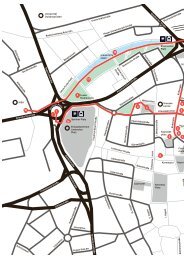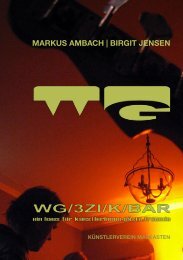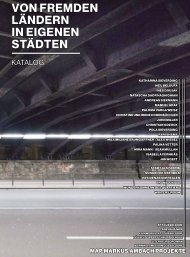B1|A40 THE BEAUTY OF THE GRAND ROAD
DIE SCHÖNHEIT DER GROSSEN STRASSE 2014 EINE AUSSTELLUNG IM STADTRAUM DER A40 VON DUISBURG BIS DORTMUND 14.06.2014 – 07.09.2014 MAP MARKUS AMBACH PROJEKTE URBANE KÜNSTE RUHR (HG.) WIENAND
DIE SCHÖNHEIT DER GROSSEN STRASSE 2014
EINE AUSSTELLUNG IM STADTRAUM DER A40 VON DUISBURG BIS DORTMUND
14.06.2014 – 07.09.2014
MAP MARKUS AMBACH PROJEKTE
URBANE KÜNSTE RUHR
(HG.)
WIENAND
You also want an ePaper? Increase the reach of your titles
YUMPU automatically turns print PDFs into web optimized ePapers that Google loves.
her meditation on concepts such as identity and a sense of belonging in<br />
the ephemeral and oscillating space along the motorway, finally finding<br />
the appropriate site at the Heißener Hof, a place distinctly similar to the<br />
farm where she grew up.<br />
Life on the road was also approached after a fashion in Volker Lang’s<br />
work. On the one hand, his 8 ½ Circus Space reflected on the circus as<br />
a dying format which used to convey the fantastic to the industrialized<br />
cities. Offsetting the characteristics of a life on the road, the work was<br />
intricately bound to the specific location, as the open circus tent offered<br />
unusual perspectives and, as a sculpture, invited the local residents to<br />
stage their own practices on the platform inside. The analogy between<br />
everyday culture and high culture made the installation on an open field<br />
in Mülheim an interface between a culture of identity and that of the other,<br />
mirrored also in the heterogeneous neighborhood in the surroundings<br />
of the Eichbaum metro station.<br />
HOME ON <strong>THE</strong> MOTORWAY Several works concerned themselves with<br />
those residents whose home is confronted with the motorway and the<br />
difficult conditions of a compulsory life amidst the flow of traffic. At<br />
Essen-Frillendorf, people are living in terraced houses only some few<br />
meters beyond the motorway lanes. To some it seems inconceivable how<br />
anybody could adapt to such a situation, whether in a traditional or a newly-built<br />
neighborhood. In his work Fixed Star, Manuel Franke displayed<br />
strategies used by the local residents to customize their own individual<br />
house in order to visualize the indispensability of the personal in the<br />
midst of an exceedingly public space. The fact that his work entered into<br />
a dialogue with the adjacent facade, which is invariably used to proclaim<br />
the neighbors’ enthusiasm for football once another world cup comes<br />
around (thus also in 2014), seemed to fit in seamlessly with the artist’s<br />
own purposes. By subtly contrasting the settled way of life with life on<br />
the road, Franke’s quasi-sculptural work was transmuted into a sophisticated<br />
discourse between place and space, moment and continuity.<br />
A bit further on up the road, Leni Hoffmann’s work utilized the situation<br />
of a village bisected by the motorway in order to address a socio-spatial<br />
subject in a similarly sculptural manner. Her intervention, which dramatized<br />
both ends of a bland concrete bridge spanning the motorway as a<br />
bracket connecting the separated districts, made tangible the conspicuous<br />
caesura of the social environment imposed by the expansion of the<br />
B1 into a motorway.<br />
Yet along the A40 one can find not only places like Frillendorf, where the<br />
drastic aspects of the motorway expansion become glaringly obvious,<br />
but also idyllic districts. In Dortmund-Schönau, John Miller’s work A False<br />
Mirror addressed a radically different situation. At the spot where the<br />
Schnettker bridge crosses the picturesque Emscher and Rüppingsbach<br />
valley, he chose the designated center of the exclusive residential area<br />
to erect two advertising columns, whose slightly anachronistic character<br />
as a non-digital advertising medium seems to mirror the atmosphere<br />
of their surroundings. On those pillars, the sleepy district, suffused with<br />
the deceptive calm of bourgeois contentment, was confronted with two<br />
fantasies of faraway places: the idyll of paradisiacal solitude was mirrored<br />
in the stereotypical depiction of a palm-studded island on the one<br />
hand and the image of a cluster of detached family homes of a first-generation<br />
gated community on the other. Both the houses of this form of<br />
settlement and the island idyll were treated as emblematic visions of an<br />
excessively individualized society; at the same time, the actual site was<br />
characterized as an exemplary instance of self-representation.<br />
NEW LANDSCAPES A crucial aspect of the motorway is bound up in its<br />
impact on the perception, existence and configuration of a landscape as<br />
a habitat. Since the time when the first American parkway engendered a<br />
comprehensive transformation of the perspective on a landscape 13 , recreating<br />
it as a large-scale travel prospect and an image of domesticated<br />
nature, it has become obvious that motorways trigger manifold social<br />
and economic changes both in cityscapes and landscapes. The question<br />
whether the concept of landscape as one distinct, complex habitat, as an<br />
interface between man, culture and nature is a sustainable proposition<br />
or whether we are merely confronted with its perennial reconstruction,<br />
was comprehensively discussed by the exhibition at various places and<br />
in various formats.<br />
In his work Redevelopment Michael Fehr pinpointed the hidden qualities<br />
of a landscape such as the Kaiserberg motorway junction area from a<br />
historical perspective. While it might appear as a piece of “virtually untouched<br />
nature” on the surface, below the ground this landscape functions<br />
as a point of intersection of various energy sources such as oil, gas,<br />
electricity and water. It thus made sense for Fehr to present the fruits of<br />
his research in the guise of a sculptural information panel on the meadows<br />
of the Dörnerhof farm, large tracts of which had fallen victim to the<br />
progressive expansion of the motorway junction.<br />
Christian Odzuck’s work Polytopos Dortmund* positioned itself in conscious<br />
relation not only to the close-by Schnettker bridge but also to<br />
the surrounding landscape. His stark construction systematized the<br />
observer’s perspective on the large-scale surroundings, juxtaposing<br />
the environment with scaled schematized shapes in the guise of<br />
landscaped embankments, oscillating between large-scale sculpture,<br />
miniature model and physical location. The work also served as both an<br />
auditorium and an object of investigation for the students of the planning<br />
department at the TU Dortmund, offering itself as an interface for<br />
the reflection on current landscape concepts. The participants of the<br />
project Ruhrbanität initiated by Christa Reicher and Ilka Mecklenbrauck<br />
approached the specifics of the landscape of the Ruhr region by means<br />
of extensive research, whose purposes and results were publicly discussed<br />
at the site of Odzuck’s work.<br />
Another aspect discussed in the exhibition was the interrelation of ecology<br />
and economy in a region whose landscapes have for a long time been<br />
exploited as a mere energy reservoir. One of the most impressive installations<br />
focusing on this subject was provided by the group Performance<br />
Electrics headed by its founder Pablo Wendel; its wind power station,<br />
built exclusively from recycled road materials, was located in a nook of<br />
the motorway junction at the outskirts of Dortmund, inviting passersby<br />
in a humorous manner to think about serious subjects such as the<br />
20












